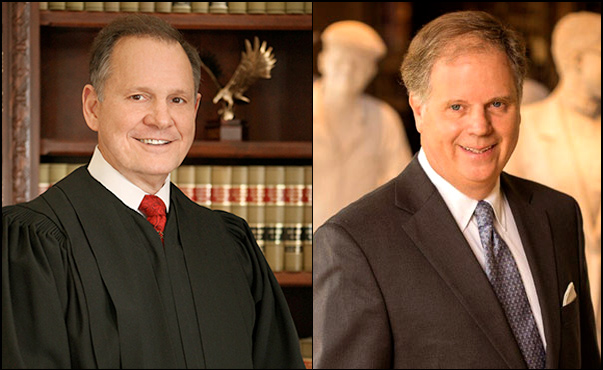
Left: Former Alabama state Supreme Court Chief Justice Roy Moore (R) | Right: Ex-US Attorney Doug Jones (D)
By Jim Ellis
Dec. 5, 2017 — Several new developments have occurred in the Alabama special Senate election, now just a week from culmination. Two new polls have been released, one from the Washington Post/Schnar School and one from CBS News/YouGov; also, the campaigns’ latest financial disclosure numbers are now public.
Prior to this weekend, the last six public polls all showed former state Supreme Court Chief Justice Roy Moore (R) regaining a small lead over ex-US Attorney Doug Jones (D). Now, the Post/Schnar poll (Nov. 27-30; 1,304 adults; 1,110 self-identified registered Alabama voters; 739 self-identified likely Alabama voters) reverses the trend (Jones up, 50-47have been released), but a further examination of the respondent universe suggests that this survey is likely within the same realm as the others.
Conversely, the CBS News/YouGov data (Nov. 28-Dec. 1; 1,067 registered Alabama voters, 68 percent of whom say they will “definitely” vote in the special Senate election) finds a much different result over virtually the same time period. According to CBS/YouGov, Judge Moore retains a 49-43 percent edge, with 71 percent of Republicans saying they believe the sexual impropriety allegations against the former state Supreme Court Chief Justice are false.
Therefore, it appears this campaign is at least toss-up or, more likely, one that is slightly leaning Moore’s way as we head into the Dec. 12 election day. The winner will serve the balance of the current term, which goes through 2020. The new senator will be eligible to seek a full six-year term in that particular regular election.
Though the Post poll projects Jones to a 50-47 percent lead, the polling sample appears to under-sample Republicans. In a state where the GOP has dominated since the 1994 election, inclusive, and a place where they control the governor’s office, all statewide elected positions, the congressional delegation (6R-1D), and both houses of the legislature by large margins, it appears that a 38R-31D self-identifying party division is light.
In comparison, the CBS/YouGov survey discerns a partisan division of 51R-36D, which appears to be more in line with recent Alabama voting history.
Since the Yellowhammer State does not register voters by political parties, it is difficult to capture the exact number of individuals affiliating with either national political entity. Therefore, the actual voter turnout figures during this special Senate cycle perhaps provides clearer substantiating evidence than a self-identification poll.
In the special Senate Republican primary several months ago (Aug. 15), 423,282 individuals cast their ballot. This compares to just 165,006 people who did likewise in the Democratic primary. For the Republican run-off (Sept. 26) between Judge Moore and appointed Sen. Luther Strange, even more people voted. In that contest, 481,186 individuals cast their ballot in the GOP run-off. Therefore, a 4:1 actual voting edge suggests that a straight party division spread would favor Republicans to a much greater degree than 38-31 percent, and aligns much better with the CBS/YouGov findings.
As expected, Jones has a major lead in financial resources, and is maximizing that advantage. Within the period from Oct. 1 – Nov. 22, the Democratic nominee raised almost $10.2 million as compared to Judge Moore’s $1.77 million. He held a cash-on-hand advantage of $2.5 million to $640,000 heading into the campaign’s final two weeks.
Though Jones has dominated the airwaves and now launched a new attack against Moore reiterating the Judge’s previously stated position that women should not serve in elected office, the polling numbers have, nevertheless, reverted back Moore’s way.
As in most special elections, this battle will come down to the voter participation factor, and which side can best get their voters to the polls on Dec. 12. At this point, Moore’s voting pool appears larger and more committed, but the situation can still change as we enter this final full week of campaigning.
